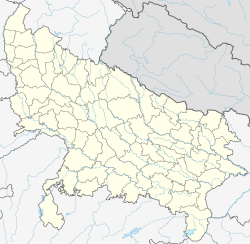world.wikisort.org - India
Pure Bansi is a large village in Dih block of Rae Bareli district, Uttar Pradesh, India.[2] It is located 21 km from Raebareli, the district headquarters.[3] As of 2011, it has a population of 667 people, in 123 households.[2] It has one primary school and no healthcare facilities, and it host a permanent market but not a weekly haat.[2] Pure Bansi belongs to the nyaya panchayat of Mau.[4]
Pure Bansi
Pura Bansi | |
|---|---|
Village | |
 Map showing Pure Bansi (#309) in Dih CD block | |
 Pure Bansi Location in Uttar Pradesh, India | |
| Coordinates: 26.209801°N 81.490157°E[1] | |
| Country | |
| State | Uttar Pradesh |
| District | Raebareli |
| Area | |
| • Total | 0.618 km2 (0.239 sq mi) |
| Population (2011)[2] | |
| • Total | 667 |
| • Density | 1,100/km2 (2,800/sq mi) |
| Languages | |
| • Official | Hindi |
| Time zone | UTC+5:30 (IST) |
| Vehicle registration | UP-35 |
The 1951 census recorded Pure Bansi as comprising 2 hamlets, with a total population of 224 people (102 male and 122 female), in 45 households and 44 physical houses.[5] The area of the village was given as 179 acres.[5] 1 resident was literate, a male.[5] The village was listed as belonging to the pargana of Rokha and the thana of Nasirabad.[5]
The 1961 census recorded Pure Bansi (as "Pure Banshi") as comprising 1 hamlet, with a total population of 258 people (134 male and 124 female), in 50 households and 50 physical houses.[6] The area of the village was given as 179 acres.[6]
The 1981 census recorded Pure Bansi as having a population of 363 people, in 109 households.[3] The main staple foods were listed as wheat and rice.[3]
The 1991 census recorded Pure Bansi as having a total population of 448 people (231 male and 217 female), in 87 households and 87 physical houses.[4] The area of the village was listed as 69 hectares.[4] Members of the 0-6 age group numbered 97, or 22% of the total; this group was 57% male (55) and 43% female (42).[4] Members of scheduled castes made up 57% of the village's population, while no members of scheduled tribes were recorded.[4] The literacy rate of the village was 11% (49 men and 1 woman).[4] 130 people were classified as main workers (all men), while 46 people were classified as marginal workers (3 men and 43 women); the remaining 272 residents were non-workers.[4] The breakdown of main workers by employment category was as follows: 112 cultivators (i.e. people who owned or leased their own land); 15 agricultural labourers (i.e. people who worked someone else's land in return for payment); 0 workers in livestock, forestry, fishing, hunting, plantations, orchards, etc.; 0 in mining and quarrying; 0 household industry workers; 0 workers employed in other manufacturing, processing, service, and repair roles; 2 construction workers; 0 employed in trade and commerce; 1 employed in transport, storage, and communications; and 0 in other services.[4]
References
- "Geonames Search". Do a radial search using these coordinates here.
- "Census of India 2011: Uttar Pradesh District Census Handbook - Rae Bareli, Part A (Village and Town Directory)" (PDF). Census 2011 India. pp. 393–409. Retrieved 19 October 2021.
- Census 1981 Uttar Pradesh: District Census Handbook Part XIII-A: Village & Town Directory, District Rae Bareli (PDF). 1982. pp. 204–5. Retrieved 19 October 2021.
- Census 1991 Series-25 Uttar Pradesh Part-XII B Village & Townwise Primary Census Abstract District Census Handbook District Raebareli (PDF). 1992. pp. xxiv–xxviii, 238–9. Retrieved 19 October 2021.
- Census of India, 1951: District Census Handbook Uttar Pradesh (42 - Rae Bareli District) (PDF). Allahabad. 1955. pp. 166–7. Retrieved 19 October 2021.
- Census 1961: District Census Handbook, Uttar Pradesh (39 - Raebareli District) (PDF). Lucknow. 1965. pp. cii-ciii of section "Salon Tahsil". Retrieved 19 October 2021.
Другой контент может иметь иную лицензию. Перед использованием материалов сайта WikiSort.org внимательно изучите правила лицензирования конкретных элементов наполнения сайта.
WikiSort.org - проект по пересортировке и дополнению контента Википедии